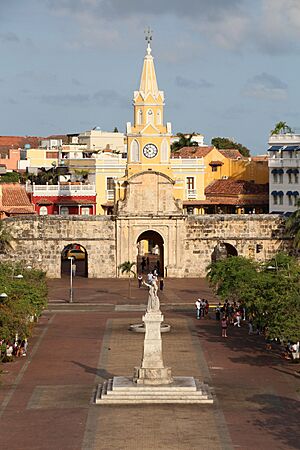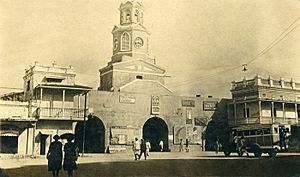Puerta del Reloj, Cartagena facts for kids
The Puerta del Reloj (pronounced PWER-tah del reh-LOH) is a famous landmark in Cartagena de Indias, Colombia. It's also called the Torre del Reloj (TOH-reh del reh-LOH) or Boca del Puente (BOH-kah del PWEHN-teh). This gate is the main entrance to the historic, walled part of the city.
You can find it between two important squares: Plaza de Independencia and Plaza de los Coches. The name "Puerta del Reloj" means "Clock Gate" because a large clock was added to it in the early 1700s. The name "Boca del Puente" means "Mouth of the Bridge." This name comes from a drawbridge that used to be right in front of the gate during the time of the Spanish colonies. This bridge connected the walled city to the Getsemaní neighborhood. It also helped defend the city. If enemies like pirates attacked, the bridge could be raised to stop them from getting in.
The gate was also protected by two strong forts called bastions. These were the San Pedro Apóstol bastion (which is gone now) and the Bastion of San Juan Bautista.
Design and Style
The Puerta del Reloj has a special architectural style called Postclassic. This style was popular in the late 1700s for building forts. The gate was designed by a military engineer named Juan de Herrera y Sotomayor. He also started the Cartagena Academy.
The gate's design looks a lot like the main church of the Monasterio de San Francisco in the Colonial City of Santo Domingo. Both gates have a rounded arch, like a Roman arch. On each side of the arch, there are two pairs of strong, simple columns. Above these columns, there's a decorative band with special carvings called triglyphs.
Experts in architecture think this gate is one of the best examples of Spanish-American fort building. It's also one of the best-preserved gates in the "New World" (the Americas). It follows the ideas of a famous French military engineer named Vauban, who had very specific rules for building strong defenses.
Many people who live in Cartagena call this gate "Boca del Puente." But visitors usually know it as the "Puerta del Reloj."
History of the Gate
The Puerta del Reloj was built between 1704 and 1738. Before that, there was an older gate called the "Puerta del Puente" (Gate of the Bridge), built in 1631. Juan de Herrera y Sotomayor was in charge of fixing and improving this older gate.
The original "Gate of the Bridge" led to a wooden bridge that was built way back in 1540. This wooden bridge crossed a small channel of seawater called the Cano de San Anastasio. This channel separated the island of Getsemaní from the island of Calamarí, where the main city was built.
See also
 In Spanish: Torre del Reloj (Cartagena de Indias) para niños
In Spanish: Torre del Reloj (Cartagena de Indias) para niños
- List of colonial buildings in Cartagena, Colombia




